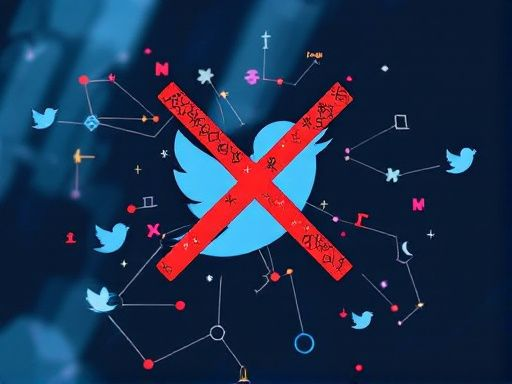Understanding Twitter’s Blocking Feature
Twitter’s blocking feature is designed to give users control over their online interactions and protect them from harassment, abuse, or unwanted content. When someone blocks a user on Twitter, it restricts that user’s ability to interact with the blocker’s account. Blocked users cannot see the blocker’s tweets, view their profile, or send them direct messages. Additionally, blocked users will not receive notifications when the blocker mentions them in a tweet or replies to one of their tweets.
It is essential to understand that blocking on Twitter is not the same as muting. Muting allows users to hide specific accounts’ tweets from their timeline without restricting their ability to interact with those accounts. Blocking, on the other hand, completely restricts interactions between the blocker and the blocked user. When someone blocks a user, Twitter does not notify the blocked user, making it challenging to determine who has blocked them.
Users may block others for various reasons, including harassment, spam, or simply because they do not want to engage with that person online. Twitter’s blocking feature is an effective way to maintain a positive online experience and protect users from unwanted interactions. However, for those who have been blocked, it can be frustrating not knowing who has blocked them or why. This is where understanding the signs of being blocked and learning how to find who blocked you on Twitter become essential.
Identifying the Signs of Being Blocked on Twitter
When someone blocks a user on Twitter, several changes occur that can indicate a block is in place. Recognizing these signs is crucial in determining whether a user has been blocked or not. The first noticeable sign is the inability to see the blocker’s tweets. If a user cannot view someone’s tweets, but knows they are actively posting, it may be a sign that they have been blocked.
Another indication of a block is receiving an error message when trying to visit the blocker’s profile. If a user attempts to access someone’s profile but is met with a message stating that the account is unavailable or does not exist, it could be a sign that they have been blocked. Furthermore, if a user is unable to send direct messages to someone, it may also indicate a block.
In addition to these signs, users may also notice that they are unable to see the blocker’s likes, retweets, or replies. If a user is aware that someone is actively engaging with others on Twitter, but their interactions are not visible, it could be a sign that they have been blocked. Users may also find that they are unable to mention or tag the blocker in tweets, which can further confirm a block.
It is essential to note that some of these signs can also be indicative of other issues, such as a user deleting their account or Twitter experiencing technical difficulties. Therefore, it is crucial to investigate further to confirm whether a block is in place. This can be done by using third-party apps or websites, checking for missing tweets or profiles, and reviewing Twitter’s email notifications. Understanding these signs and taking steps to confirm a block can help users determine whether they need to take action to resolve the issue.
For users searching for answers on how to find who blocked me on Twitter, recognizing these signs is the first step in uncovering the identity of their blocker. By acknowledging these indicators and taking the necessary steps to confirm a block, users can begin to address the issue and potentially resolve the situation.
How to Find Out Who Blocked You on Twitter
Discovering who blocked you on Twitter can be a challenging task, as the platform does not provide direct notifications or alerts when someone blocks your account. However, there are several methods that can help uncover the identity of the blocker, including using third-party apps or websites, checking for missing tweets or profiles, and reviewing Twitter’s email notifications.
To start, users can try searching for the suspected blocker’s Twitter handle or username in the search bar. If the account is not visible in the search results, it may indicate that the user has been blocked. Another approach is to check for missing tweets or profiles, as blocked accounts will not be able to view the blocker’s tweets or access their profile.
Reviewing Twitter’s email notifications can also provide clues about who blocked you. When someone blocks your account, Twitter may send an email notification indicating that your tweet has been flagged for spam or abuse. By examining the email notification, users may be able to identify the blocker’s username or handle.
For those who want to know how to find who blocked me on Twitter, utilizing third-party apps or websites can be an effective solution. These tools can help detect Twitter blocks by analyzing the user’s account activity, follower list, and tweet engagement. Some popular third-party apps and websites for detecting Twitter blocks include Block Together, Twitter Block Checker, and Who Blocked Me.
To use these tools, users typically need to authorize the app or website to access their Twitter account. Once authorized, the tool will scan the user’s account data and provide a list of suspected blockers. While these tools can be useful, it is essential to note that they may not always provide accurate results, and users should exercise caution when using third-party apps or websites.
Another approach to finding out who blocked you on Twitter is to use the “TweetDeck” method. This involves creating a new column in TweetDeck, a Twitter management tool, and adding the suspected blocker’s username or handle to the column. If the user has been blocked, the column will not display any tweets from the blocker’s account.
Ultimately, discovering who blocked you on Twitter requires patience, persistence, and creativity. By using a combination of these methods, users can increase their chances of uncovering the identity of their blocker and take steps to address the situation. For those seeking answers on how to find who blocked me on Twitter, these strategies can provide a useful starting point.
Using Third-Party Tools to Detect Twitter Blocks
When trying to figure out how to find who blocked me on Twitter, utilizing third-party tools can be an effective approach. These tools are specifically designed to help users detect Twitter blocks and uncover the identity of their blockers. Some popular options include Block Together, Twitter Block Checker, and Who Blocked Me.
Block Together is a free, open-source tool that allows users to detect and manage Twitter blocks. By connecting a Twitter account to the tool, users can scan their followers and identify any accounts that have blocked them. Block Together also provides features such as block tracking, which enables users to monitor their block list and receive notifications when someone blocks them.
Twitter Block Checker is another popular tool that helps users detect Twitter blocks. This tool uses a simple and intuitive interface, allowing users to enter a Twitter handle and instantly check if they have been blocked by that account. Twitter Block Checker also provides a block list feature, which enables users to track and manage their blocked accounts.
Who Blocked Me is a user-friendly tool that provides a comprehensive block detection service. By connecting a Twitter account to the tool, users can scan their followers and identify any accounts that have blocked them. Who Blocked Me also offers a block tracking feature, which enables users to monitor their block list and receive notifications when someone blocks them.
When using third-party tools to detect Twitter blocks, it is essential to consider their effectiveness and reliability. While these tools can be useful in identifying blockers, they may not always provide accurate results. Therefore, it is crucial to use multiple tools and cross-check the results to ensure accuracy.
In addition to using third-party tools, users can also employ other methods to detect Twitter blocks. For instance, checking for missing tweets or profiles, reviewing Twitter’s email notifications, and analyzing follower lists can all help identify potential blockers. By combining these methods with third-party tools, users can increase their chances of uncovering the identity of their blockers and understanding how to find who blocked me on Twitter.
What to Do If You’ve Been Blocked on Twitter
Being blocked on Twitter can be frustrating, especially if it’s by someone with whom you had a meaningful interaction or connection. However, there are steps that can be taken to address the situation and potentially resolve the issue. Before diving into the process of how to find who blocked me on Twitter, it’s essential to understand the possible reasons behind the block and the best course of action to take.
If the block is a result of a misunderstanding or a minor disagreement, it may be possible to appeal the block by reaching out to the person who blocked you through other means, such as email or another social media platform. However, it’s crucial to respect their decision and boundaries if they choose not to engage.
If the block is a result of harassment or abuse, it’s essential to take responsibility for one’s actions and acknowledge the harm caused. In such cases, it’s best to take a step back, reflect on the behavior, and make amends if possible. Twitter’s blocking feature is in place to protect users from harm, and it’s essential to respect the platform’s rules and guidelines.
If the block is unjust or a result of a technical glitch, users can contact Twitter support for assistance. Twitter provides a comprehensive help center with resources and guides on how to resolve common issues, including blocks. Users can also submit a report to Twitter’s support team, providing detailed information about the issue, including the username of the person who blocked them and any relevant screenshots or evidence.
It’s also essential to remember that being blocked on Twitter is not the end of the world. There are millions of users on the platform, and it’s possible to build meaningful connections and engage in respectful conversations with others. Instead of dwelling on the block, users can focus on nurturing their existing relationships and building a supportive community.
Ultimately, being blocked on Twitter can be a valuable learning experience, providing an opportunity to reflect on one’s behavior and online interactions. By taking responsibility for one’s actions, respecting others’ boundaries, and engaging in positive and respectful conversations, users can maintain a healthy and enjoyable Twitter experience.
Preventing Future Blocks on Twitter
While understanding how to find who blocked me on Twitter can be helpful, preventing future blocks is a more effective approach to maintaining a positive online presence. To minimize the risk of being blocked, users should focus on creating respectful and engaging content that adds value to the Twitter community.
One key strategy is to be mindful of tweet content, avoiding posts that could be perceived as spam, harassment, or abuse. This includes refraining from sending unsolicited messages, posting repetitive or irrelevant content, and using inflammatory language. By being thoughtful and considerate in online interactions, users can reduce the likelihood of being blocked.
Another important aspect of preventing future blocks is to engage in respectful conversations. This involves listening to others, responding thoughtfully, and avoiding confrontational or aggressive language. By fostering a positive and respectful dialogue, users can build trust and credibility within the Twitter community, reducing the risk of being blocked.
Additionally, users should be aware of Twitter’s community guidelines and terms of service, which outline the platform’s expectations for user behavior. By familiarizing themselves with these guidelines, users can ensure that their online activities align with Twitter’s standards, minimizing the risk of being blocked or suspended.
It’s also essential to recognize that being blocked is not always a personal attack. In some cases, users may be blocked due to a misunderstanding or a misinterpretation of their online behavior. By maintaining a professional and respectful online presence, users can reduce the likelihood of being blocked and create a positive Twitter experience for themselves and others.
Ultimately, preventing future blocks on Twitter requires a combination of self-awareness, respect for others, and a commitment to creating positive online interactions. By adopting these strategies, users can minimize the risk of being blocked and maintain a healthy and engaging online presence.
Twitter’s Blocking Policy and Guidelines
Twitter’s blocking policy and guidelines are designed to promote a safe and respectful environment for all users. The platform takes harassment and abuse seriously, and blocking is one of the tools available to users to manage their interactions and protect themselves from unwanted or abusive behavior.
According to Twitter’s guidelines, harassment is defined as behavior that is intended to intimidate, threaten, or silence others. This can include, but is not limited to, sending unsolicited or threatening messages, posting abusive or hateful content, or engaging in repetitive or targeted behavior that is intended to harass or intimidate others.
If a user is found to be engaging in harassment or abuse, Twitter may take action, including suspending or terminating their account. Users who are experiencing harassment or abuse can report the behavior to Twitter using the platform’s reporting tools.
In addition to reporting harassment or abuse, users can also block other users to prevent them from seeing their tweets, sending them direct messages, or interacting with them in other ways. Blocking is a useful tool for managing interactions and protecting oneself from unwanted or abusive behavior.
When it comes to finding out who blocked you on Twitter, it’s essential to understand the platform’s blocking policy and guidelines. By familiarizing yourself with these guidelines, you can better navigate the platform and avoid engaging in behavior that may result in being blocked. Additionally, understanding Twitter’s blocking policy can help you identify potential issues and take steps to resolve them.
For users searching for answers on how to find who blocked me on Twitter, understanding the platform’s blocking policy and guidelines is an essential step. By recognizing what constitutes harassment or abuse and taking steps to avoid engaging in such behavior, users can reduce the likelihood of being blocked and maintain a positive Twitter experience.
Maintaining a Positive Twitter Experience
Maintaining a positive Twitter experience is crucial for individuals and businesses alike, as it allows users to focus on meaningful interactions, build a supportive community, and promote healthy online relationships. When users are aware of how to find who blocked me on Twitter, they can better navigate the platform and create a more enjoyable experience for themselves and others. By emphasizing respectful conversations, being considerate of diverse perspectives, and adhering to Twitter’s guidelines, users can foster a positive environment that encourages engagement and connection.
One effective way to maintain a positive Twitter experience is to prioritize high-quality content that adds value to the conversation. This can include sharing relevant news, personal anecdotes, or insightful commentary that sparks meaningful discussions. By focusing on substance over noise, users can attract like-minded individuals who share similar interests and passions, ultimately creating a supportive community that promotes healthy online relationships.
Another essential aspect of maintaining a positive Twitter experience is to be mindful of online etiquette. This includes avoiding spam or harassment, refraining from inflammatory language, and being considerate of others’ feelings and opinions. By being respectful and empathetic, users can create a safe and welcoming environment that encourages open dialogue and fosters meaningful connections.
Ultimately, maintaining a positive Twitter experience requires a combination of self-awareness, online etiquette, and a commitment to creating high-quality content. By being aware of how to find who blocked me on Twitter and taking proactive steps to promote a positive environment, users can unlock the full potential of the platform and enjoy a more rewarding and engaging experience. By focusing on what matters most – building meaningful relationships and engaging in respectful conversations – users can create a Twitter experience that is both enjoyable and enriching.



